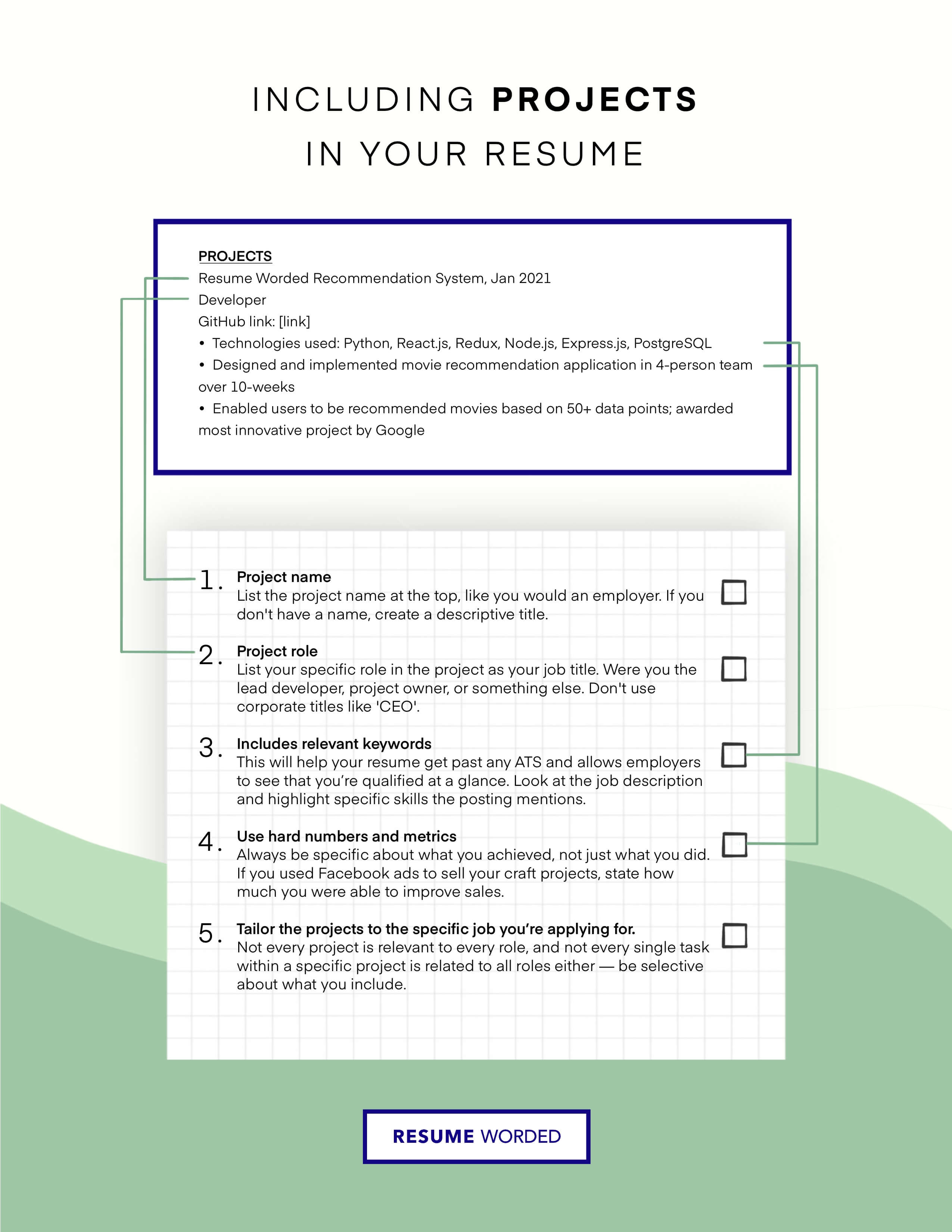Projects are a frequently overlooked but potentially high-value resume addition. This is especially true if you’re an entry-level job seeker or considering changing careers — the right project can help fill out a less than robust work experience section and prove to hiring managers that you have the essential skills for the job you’re applying for.
In this article, we’ll cover:
- Exactly which project details need to go on your resume — and which don’t
- How to write project details in a resume
- What part of your resume projects belong in
- Project-based resume templates and examples
- Selected project ideas that look great on any resume
Let’s start by looking at the most essential project details to list on your resume.
Essential project details to include in a resume
At a minimum, projects on your resume should include:
- The project title
- A short description of the project
- The dates you worked on the project
- Who or what the project was for, e.g. your employer, school, or personal project
- Your specific role
- The specific task(s) you performed
- Key technologies used
- The results or impact of the project
- The people you collaborated with (if appropriate)
- A link to the project
That seems like a lot of information, but it doesn’t have to take up a huge amount of space on your resume — keep scrolling for details, including templates and examples.
How to write project details in a resume
- In your Work Experience, Projects, or Additional section, create a “Key Projects” subheading.
- Write the project name and/or a brief description of what it did.
- List your employer, staffing agency, or consulting firm.
- List your job title. If you were self-employed, give yourself a standard job title.
- List the dates of employment.
- Include 1-2 accomplishments in bullet point format.
- Add a link to a GitHub profile, website, or online portfolio.
- Double check that you haven’t missed anything (including essential keywords or hard skills) by using our free ATS resume scanner.
Here’s an example of including project-based experience in your work experience section:
If your projects weren’t work-based but are still highly relevant, you could create a separate projects section:
If the project wasn’t directly relevant to the job you’re applying for — or if you’re running low on space — include it briefly in an additional section:
I’d recommend uploading your resume to the tool below to find out if you have structured your projects (and project details) the right way. It’ll also scan your resume sections and let you know which details belong on your resume and which ones to leave off entirely.
Sample project-based resume
Let’s take a look at a resume template that’s ideal for showcasing specific project-based experience:
This resume example has taken selected project experience and extended it out to include specific accomplishments, including project details and key metrics. Because these projects were essential to the role, here they’re included in the work experience section, but you could easily move them to a projects or additional section if they’re less relevant.
Download this free template (and others) from our ATS resume templates page.
Frequently asked questions
Should I put projects on my resume?
Short answer? Yes!
Longer answer? If:
- The project was relevant to the job you’re applying for
- You don’t have a lot of other, more relevant experience
- You want to highlight key technical skills necessary for the role
Then you should definitely make space for a projects section. If you already have extensive work experience without including projects, you can probably leave them off.
What kind of projects should I include on a resume?
Any kind of project can go on your resume. This includes work projects, university projects, and even personal or hobby projects.
Do personal projects count as experience?
Not in the strictest sense — meaning, you shouldn’t list them under a “Work Experience” heading unless you’ve actually used them at work. But yes, they do show hiring managers that you have some experience using relevant software, programming languages, or other technical skills, and they can count toward your years of experience or level of proficiency.
Should I list project roles and responsibilities in a resume?
Yes, but don’t list them as “roles and responsibilities.” Your role in the project can double as your job title, but try to focus on your accomplishments rather than your responsibilities.
What kind of projects look good on a resume?
Any — as long as they’re relevant! If you’re just starting out, you could include:
- Projects you completed as part of your university coursework
- Extracurricular projects
- Capstone projects
- Personal projects, hobbies, or side gigs










